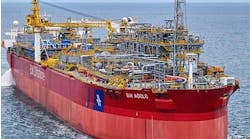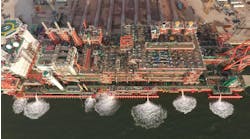Final EPC phase for Pemex's Cantarell
Final EPC phase for Pemex's Cantarell
The final phase of a massive project to significantly boost gas processing and injection on the Cantarell Field offshore Mexico is underway. Corporacion Mexicana de Mantenimiento Integral SA de CV (COMMISA), a Mexican corporation 99% owned by Kellogg Brown & Root (KBR), is providing engineering, project management, procurement, construction, offshore installation, hook-up, commissioning, and start-up of the gas processing facilities.
Scheduled for completion in early 2002, the EPC-01 project is valued at more than $650 million, making it one of the largest offshore ventures ever undertaken by Pemex. The gas processing facility will be the largest of its kind in the Gulf of Mexico, with a processing capability close to 1,000 MMcf/d.
The facilities are equipped with gas sweetening, dehydration, and compression systems. The facilities include the Gulf's largest offshore waste heat recovery system, rated at 900 MMbtu. The facilities also boast the largest desalination system in the Gulf of Mexico and the largest offshore hydrocarbon condensate recovery unit. The condensate unit has a capacity of over 100,000 b/d of oil.
These major components are being integrated into the existing Akal-C complex to provide gas for re-injection to enhance oil production capacity in the Cantarell Field. Work done so far includes:
- Process design and detailed engineering of the facilities
- Procurement and delivery of 50,000 tons of equipment and materials
- Construction and installation of 15,000 tons of substructures and piling
- Construction and installation of 30,000 tons of process facilities.
Work remaining includes final interconnection work offshore, facilities commissioning, initial start up, and production trials prior to handing the facilities over to Pemex for production.
Subsea contracts for Statoil's Sigyn, Mikkel
FMC Energy Systems has signed an agreement with Statoil ASA to provide equipment and technology solutions for the Sigyn development project in the Norwegian sector of the North Sea. The Sigyn Field is a subsea tieback to the Sleipner A platform. The subsea completion solution will be provided by FMC Kongsberg Subsea, the company's Norwegian-based subsidiary. The solution is made up of one subsea template, three subsea trees, umbilicals, and a control system. The contract for this equipment is valued at approximately $19 million. Peter D. Kinnear, Vice President of FMC Energy Systems, anticipated "delivering the complete solution in less than a year."
FMC Energy Systems also has signed a similar agreement with Statoil to provide solutions for the Mikkel development, which is also located in the Norwegian sector of the North Sea. This contract is valued at around $40 million. The Mikkel Field is a tieback to the
Subsea pig launcher does not require production halt
Halliburton Subsea has teamed up with GD Engineering, a UK-based pipeline pigging system specialist, to offer the offshore industry a new subsea pig launcher (SPL) for use in deepwater applications. The alliance provides oil and gas field operators with the design, fabrication, installation, and servicing of the SPL. The system is capable of operating at a design pressure of 10,000 psig in up to 10,000 ft water depth. The new SPL is ready for field application.
Because the pig launcher does not require two flowlines, it can provide a cost-effective solution to flow assurance problems in long subsea tiebacks. The conventional method of connecting satellite fields to host facilities requires dual flowlines. The two lines allow round-trip pigging operations, which are used to clean the lines. The Halliburton/GD Engineering option can be launched from one end of a single flowline and retrieved at the host facility. This one-way trip enables operators to use a single flowline for tieback, resulting in field development cost savings. The pipelines can be pigged without halting production.
The SPL holds 10 to 12 conventional pigs and uses a proven, remotely operated hydraulic pig delivery system from the service umbilical to ensure that positive control of pig displacement and release is achieved. The system overcomes problems commonly associated with "pig hang-up" in more conventional gravity-feed systems. This new design development allows the SPL to be installed in both vertical and horizontal orientations. The reloading of pigs is carried out from a standard remotely operated vehicle (ROV) support vessel. Only the initial SPL installation and launcher barrel recovery require the use of a multi-service vessel (MSV).
To avoid the release of hydrocarbons or methanol, environmentally friendly hydraulic fluid is used to launch the pigs into the flowline. Since no hydrocarbons or methanol are allowed to enter the retrievable section of the SPL, the solution is truly "green." This also allows the pigs to be left in the launcher barrel on the seabed for extended periods without degradation.
Stolt Offshore forms Paragon-Litwin
Stolt Offshore is acquiring Ingerop Litwin, a Paris-based engineering company, from the French engineering group VINCI.
Ingerop Litwin will merge with the newly formed affiliate of Stolt Offshore, Paragon Europe, which will be renamed Paragon-Litwin. Ingerop Litwin has historically dedicated 80% of its business to EPIC projects in upstream offshore and onshore engineering and in gas plant, petrochemical, refinery, and power plant projects. The remaining 20% of the company's business has been focused on engineering and project management services.
"Paragon-Litwin's downstream capability helps to diversify our portfolio while providing avenues for expansion into new markets," said Ken Arnold, Chief Executive Officer of Paragon-Litwin and Paragon Engineering Services, Inc.




